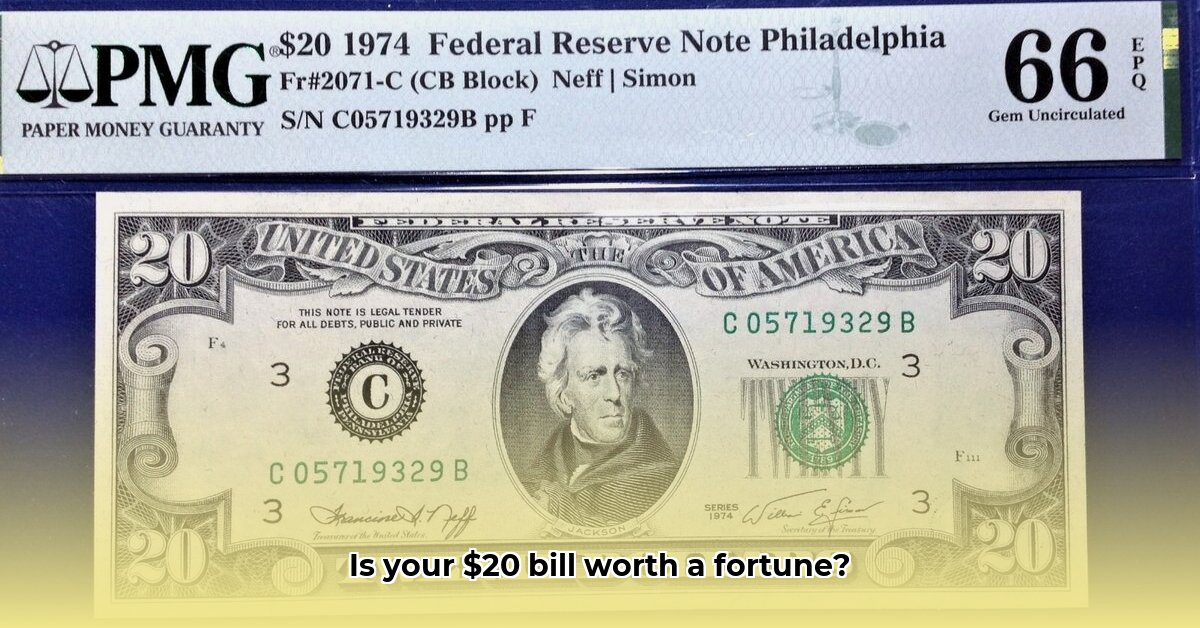
So, you've found a 1974 $20 bill? Its value isn't a simple answer; it depends on several key factors. This guide will help you determine its worth, whether you're a seasoned collector or just curious. We'll cover grading, identifying errors, and finding comparable sales data, empowering you to assess your bill's potential. For more on valuable currency, check out this guide on 1861 half dollar value.
Factors Affecting Value: Unlocking Your Bill's Potential
Several interconnected elements determine a 1974 $20 bill's value. Let's explore how each contributes to its worth:
Condition: The Foundation of Value
A bill's physical condition is paramount. Numismatists use the Sheldon Scale (a 70-point scale) to grade notes, ranging from Poor (1) to Gem Uncirculated (70). A Gem Uncirculated bill, appearing virtually as-issued, commands significantly higher prices than a heavily circulated one. The difference can be substantial – a poorly preserved bill might be worth face value, while a pristine example could be valued in the hundreds.
Error Notes: When Imperfections Become Valuable
Printing errors, or error notes, can dramatically increase a bill's worth. These "mistakes" range from subtle misprints (like slightly blurry ink) to significant printing flaws. Common error types to look for include:
- Star Notes: These bills have an asterisk (*) replacing a letter in the serial number. While not all star notes are particularly valuable, those from certain Federal Reserve Banks become especially sought-after.
- Misprints: These are deviations from the standard printing process, such as off-center printing, ink bleeds, or misaligned elements on the bill's design.
Identifying such errors requires a keen eye and detailed examination. Online resources offer visual guides and comparisons.
Issuing Bank: The Geographic Factor
Each Federal Reserve Bank (identified by a letter code on the bill) printed 1974 $20 bills. The quantity of bills printed by each bank varies; bills issued by banks with lower production runs are typically more valuable due to rarity. For example, Minneapolis Federal Reserve notes are often highly desired among collectors.
Serial Numbers: The Number Game
The serial number itself can significantly impact worth. Certain characteristics like low numbers, repeating digits, or patterns (known as "fancy serial numbers") are more attractive to collectors and command premium prices, especially in conjunction with high-grade conditions.
Grading and Authentication: Establishing Credibility
Accurately assessing your bill requires a thorough understanding of grading and authentication. The Sheldon Scale, while a useful guideline, relies heavily on subjective assessment. For valuable bills, professional authentication from reputable services like PCGS (Professional Coin Grading Service) or NGC (Numismatic Guaranty Corporation) provides a crucial assessment of authenticity and condition which significantly increases a bill's market value.
Identifying Error Notes: Becoming a Note Detective
Identifying error notes begins with careful observation. Compare your bill to images of known error notes found online and in numismatic publications. Pay close attention to:
- Ink clarity and consistency: Look for blurry images or ink-bleed issues.
- Alignment: Is the printing perfectly centered? Off-center printing is a common error type.
- Serial number variations: Check for star notes or other anomalies within the serial number itself.
Finding and Valuing Your Bill: Research is Key
Once you've examined your bill, research is crucial for determining its potential market value.
- Online Price Guides: While useful starting points, online guides provide only estimates. Use them cautiously, realizing that they represent averages, not definitive prices.
- Auction Results: Reputable auction houses (like Heritage Auctions) often publish past sales data. Comparing your bill to similar ones sold can provide meaningful insights into potential price ranges. Websites dedicated to banknotes also offer this information. However, be aware that prices can fluctuate significantly.
- Professional Appraisal: If your bill has a high potential value due to factors like its condition, error features, or serial number, consider a professional appraisal for a definitive valuation.
Building a Collection: A Rewarding Journey
Building a currency collection is a rewarding hobby. Begin with learning and understanding the basics of grading and identification, starting with more common and less expensive bills. Gradually expand your knowledge and collection into rarer and more valuable notes. Join online forums and numismatic organizations. Learning from experienced collectors is invaluable.
Risks and Considerations: Navigating the Collector's Market
Collectors face several risks:
- Counterfeits: Be wary of fraudulent notes; research and authentication are vital against counterfeiting.
- Overvaluation: Avoid emotional decision-making. Research objectively and consult multiple sources for balanced valuation.
- Market Fluctuations: The value of collectible items can change over time.
Conclusion: Unlocking the Value Within
Determining the value of your 1974 $20 bill is a multi-faceted process. Through careful examination, research, and perhaps professional guidance, you can uncover the true potential of your discovery. Happy collecting!